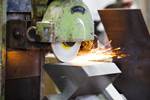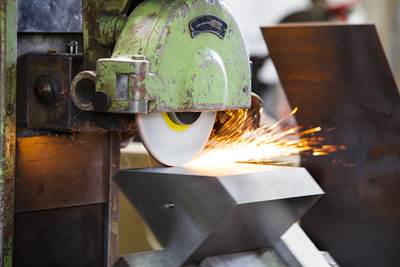Grinding Wheel Safety: Respect The Maximum Speed
One potential source of serious injury in grinding comes from an oversight that is easy to make: operating the wheel in an over-speed condition.

One potential source of serious injury in grinding comes from an oversight that is easy to make: operating the wheel in an over-speed condition. While a wheel that is run far enough in excess of its rated maximum speed may shatter within minutes of operation, danger may also result from a wheel run just slightly faster than its rated speed. This less severe over-speed condition can cause the wheel to be damaged, and the damage may result in breakage after further use. For example, operating a reinforced, 9-inch diameter, Type 27 wheel rated for a maximum speed of 6,600 rpm on a 7-inch angle grinder with a speed of 7,700 rpm can cause the wheel to crack. This cracking can lead to breakage later.
What other actions lead to an over-speed condition?
The following actions—all of which are not recommended—can also lead to an over-speed condition:
- Mounting the grinding wheel on a sander, such as a “pistol grip” air sander
- Mounting the wheel directly on an electric motor
- Mounting the wheel on the wrong machine size for that wheel
- Failing to properly maintain machine components, particularly governors on pneumatic machines and linkages on floorstand machines
- Using the incorrect air, hydraulic or electric power supply
- Using an improper speed setting on the machine
Any of these actions sets up a disastrous scenario that could lead to an accident involving serious injury or death.
The hazard of running in an over-speed condition comes from centrifugal force. A result of rotary motion, centrifugal force is what causes a weight on the end of a string to pull the string taught when the weight is swung in a circle. This same force causes the mass of the grinding wheel to be pulled outward from the center of rotation as the wheel is spinning.
Danger comes from the fact that centrifugal force does not increase in direct proportion to an increase in speed, but instead it increases as the square of that speed increase. When rotational speed doubles, centrifugal force quadruples. This effect means that relatively small changes in speed can produce significant increases in force. In the example mentioned, changing from 6,600 rpm to 7,700 rpm multiplies the speed by 1.167. However, the corresponding centrifugal force would multiply by a factor of 1.167 × 1.167, or 1.36.
To take a more extreme example, consider the same wheel with a maximum safe operating speed of 6,600 rpm run on a 5-inch right angle grinder at 10,000 rpm. This represents an over-speed of about 1.5 times the wheel’s designed speed. But the corresponding centrifugal force—and the corresponding rotational stress on the wheel—would be about 2.3 times as much as the maximum allowed.
In short, never over-speed a grinding wheel. The speed of the grinder must be compared to the speed marked on the wheel or package to make sure the machine’s speed is at or below the maximum operating speed of the wheel. Surpassing this rating risks not just wheel breakage but also the safety of shop personnel.
About the Author
Roger Cloutier is a senior product safety engineer for the Norton Abrasives brand of Saint-Gobain Abrasives in Worchester, Massachusetts.
Related Content
Threading On A Lathe
The right choices in tooling and technique can optimize the thread turning process.
Read MoreBuying a Lathe: The Basics
Lathes represent some of the oldest machining technology, but it’s still helpful to remember the basics when considering the purchase of a new turning machine.
Read MoreWhen Organic Growth in Your Machine Shop Isn’t Enough
Princeton Tool wanted to expand its portfolio, increase its West Coast presence, and become a stronger overall supplier. To accomplish all three goals at once, acquiring another machine shop became its best option.
Read MoreChoosing The Right Grinding Wheel
Understanding grinding wheel fundamentals will help you choose the right wheel for the job.
Read MoreRead Next
Choosing The Right Grinding Wheel
Understanding grinding wheel fundamentals will help you choose the right wheel for the job.
Read MoreThe Cut Scene: The Finer Details of Large-Format Machining
Small details and features can have an outsized impact on large parts, such as Barbco’s collapsible utility drill head.
Read More3 Mistakes That Cause CNC Programs to Fail
Despite enhancements to manufacturing technology, there are still issues today that can cause programs to fail. These failures can cause lost time, scrapped parts, damaged machines and even injured operators.
Read More.jpg;maxWidth=970;quality=90)







.jpg;maxWidth=300;quality=90)









.png;maxWidth=300;quality=90)







